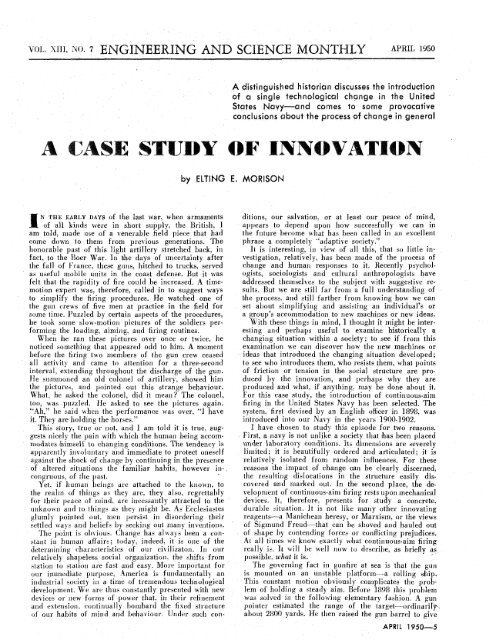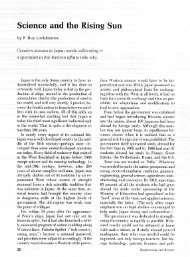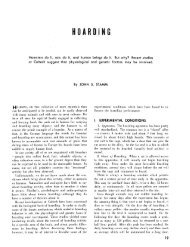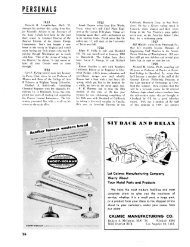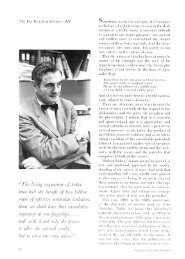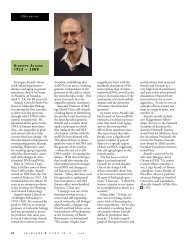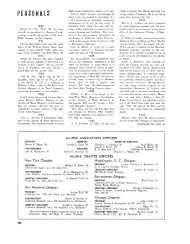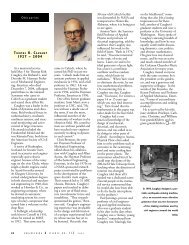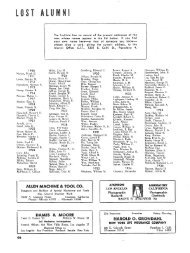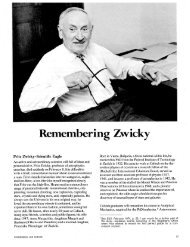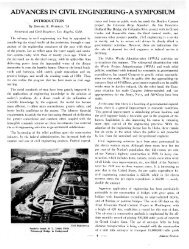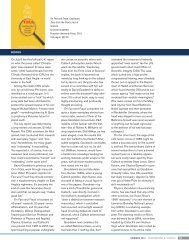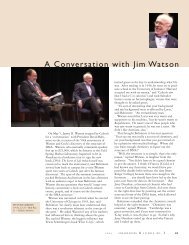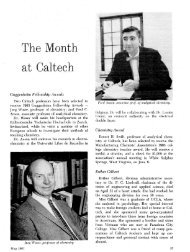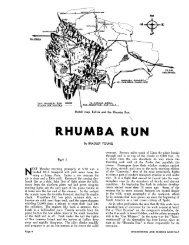T - Engineering & Science - California Institute of Technology
T - Engineering & Science - California Institute of Technology
T - Engineering & Science - California Institute of Technology
You also want an ePaper? Increase the reach of your titles
YUMPU automatically turns print PDFs into web optimized ePapers that Google loves.
VOL. XJI1, 30. 7 y APRIL 1950<br />
by ELTING<br />
K THE EARLY DAYS <strong>of</strong> the last war, when armaments<br />
<strong>of</strong> all hilids were in short supply, the British, 1<br />
am told, made use <strong>of</strong> a venerable field piece that had<br />
come down to them from previous generations. The<br />
honorable past <strong>of</strong> this light artillery stretched back, in<br />
fact, to the Boer War. In the days <strong>of</strong> uncertainty after<br />
the fall <strong>of</strong> France. these guns, hitched to trucks, served<br />
as useful mobile units in the coasL defense. But it was<br />
felt that the rapidity <strong>of</strong> fire could be increased. A timemotion<br />
expert was, therefore, called in to suggest ways<br />
to simplify the firing procedures. He watched one <strong>of</strong><br />
the gun crews <strong>of</strong> five men at practice in the field for<br />
some time. Puzzled by certain aspects <strong>of</strong> the procedures,<br />
he took some blow-motion pictures <strong>of</strong> the soldiers performing<br />
the loading. aiming. and tiring routines.<br />
When he ran these pictures over once or twice. he<br />
noticed something that appeared odd to him. A moment<br />
before the firing tho members <strong>of</strong> the gun crew ceased<br />
all activitj and came to attention for a three-second<br />
interval, extending throughout the discharge <strong>of</strong> the gun.<br />
He summoned an old colonel <strong>of</strong> artillery, showed him<br />
the pictures, and pointed out this strange behaviour.<br />
What. he asked the colonel, did it mean? The colonel,<br />
too, was puzzled. He asked to see the pictures again.<br />
'"Ah." lie said when the performance was over. "I have<br />
it. They are holding the horses.'<br />
This story, true ur not, and 1 am told it is true. suggests<br />
nicely the pain with which the human being accomniodates<br />
himself to changing conditions. The tendency is<br />
apparently imoluntary and immediate to protect oneself<br />
against the shock <strong>of</strong> change by continuing in the presence<br />
<strong>of</strong> altered situations the familiar habits, however incongruous.<br />
<strong>of</strong> the past.<br />
Yet. if 11mnan beings are attached to the known. to<br />
the ~ealm <strong>of</strong> things as they are. they also. regrettably<br />
for their ped(:e <strong>of</strong> rniiid. are incessantly attracted to the<br />
unknown and to thing- as the) might be. As Ecclesiasles<br />
glumly pointed out. men persist in disordering their<br />
settled way;. and beliefs by seeking out main ir~~entioiis.<br />
r ><br />
the point is oinious. Change has always been a constant<br />
in human affairs; today, indeed. it is one <strong>of</strong> the<br />
deteniiining ('hdiart~ristich <strong>of</strong> our civilizator~. In our<br />
relatively shapeless social organization. the shifts from<br />
station to stdtion are fast and easy. More important for<br />
our immediate purpose, herica is fun darn en tall^ an<br />
industrial societj in a time <strong>of</strong> treniendoua technological<br />
development. We are thus constantly presented with new<br />
ileiiceb or new foims <strong>of</strong> power that, in their refinement<br />
and extthiision. continually bombard the fixed structure<br />
<strong>of</strong> our habits <strong>of</strong> n~ind and buhaiiour Under such con-<br />
A distinguished historian discusses the introduction<br />
<strong>of</strong> a single technological change in the United<br />
States Navy-and comes to some provocative<br />
conclusions about the process <strong>of</strong> change in general<br />
E. MORISON<br />
ditions, our salvation. or at least our peace <strong>of</strong> mind,<br />
appears to depend upon how successfully we can in<br />
the future become hat has been called in an excellent<br />
phrase a completely "adaptive society."<br />
It is interesting, in view <strong>of</strong> all this, that so little invebtigation,<br />
relati\ely. has been made <strong>of</strong> the process <strong>of</strong><br />
change and human responses to it. Recently psychologists,<br />
sociologists and culiural anthropologists have<br />
addressed themselves to the subject with suggestive results.<br />
But we are still far from a full understanding <strong>of</strong><br />
the process, and still farther from knowing how we can<br />
set about simplifying and assisting an individual's or<br />
a group's accomn~odation to new machines or new ideas.<br />
With these things in mind, 1 thought it might be interesting<br />
and perhdps useful to examine historically a<br />
changing situation within a society; to see if from this<br />
examination we can discover how the new machines or<br />
ideas that introduced the changing situation developed;<br />
to see who introduces them, who resists them, what points<br />
<strong>of</strong> friction or tension in the social structure are produced<br />
by the innovation, and perhaps why they are<br />
produced and what, if anything. may be done about it.<br />
For this case study, the introduction <strong>of</strong> continuous-aim<br />
firing in the United States Navy has been selected. The<br />
systen:. first devised by an English <strong>of</strong>ficer in 1898. was<br />
introduced into our Navy in the years 1900-1902.<br />
I have chosen to study this episode for two reasons.<br />
First, a navy is not unlike a society that has been placed<br />
under laboratory conditions. lts dimensions are severely<br />
limited; it is beautifully ordered and articulated; it is<br />
relatively isolated from random influences. For these<br />
reasons the impact <strong>of</strong> change can he clearly discerned,<br />
the resulting dislocations in the structure easily discovered<br />
and marked out. In the second place, the developn~ent<br />
<strong>of</strong> coritinuons-aim firing rests upon mechanical<br />
devices. It, therefore. presents for study a concrete.<br />
durable situation. It is not like many other innovating<br />
reagents-a Manichean heresy, or Marxism, or the views<br />
<strong>of</strong> Sigmund Freud-that can be shoved and hauled out<br />
<strong>of</strong> shape I)} contending forces or conflicting prejudices.<br />
At all tirnes we know exartjy what continnous-aim firing<br />
really i2. It will be well now to describe, as briefly as<br />
possible. uihat it is.<br />
The governing fact in gunfire at sea is that the gun<br />
is mounted on an unstable platform-a rolling ship.<br />
This constant motion obiiously complicates the problem<br />
<strong>of</strong> holding a stead) aim. Before 1898 this problem<br />
was solved in the following elementary fashion. A gun<br />
pointer estimated the range <strong>of</strong> the target---ordinarily<br />
about 2800 yards. He then raised the gun barrel to give<br />
APRIL 1950-5


